21 Types of Pothos with Pictures (Rare & Common)
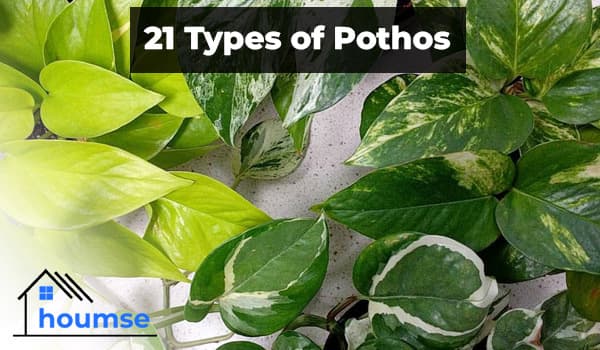
If you are a houseplant enthusiast, you are probably curious about types of pothos. Different types of pothos (Epipremnum aureum) are often among the first houseplants that we have had; since they are easy to grow indoors and require minimum care.
In general, different types of pothos plants have long trailing stems and beautiful heart-shaped leaves. Today, we will take a look at some of the most popular varieties of this tropical vine plant, so you can also tell the rare pothos apart.
Must-Know Pothos Varieties
These species have similar requirements. However, they display various eye-catching foliage, some of which are more appealing to each novice or professional gardener. Here are 21 pothos varieties you must know:
Manjula Pothos (Epipremnum aureum ‘Manjula’)
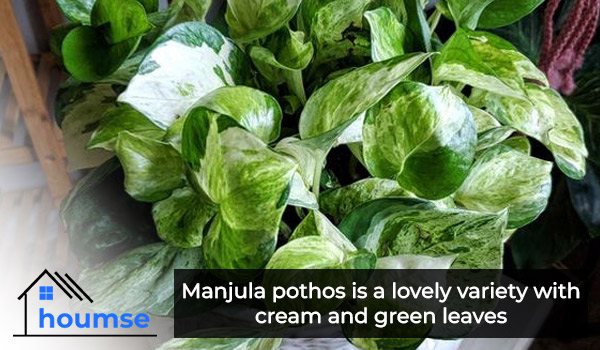
Among different types of pothos, Manjula pothos is a lovely variety with cream and green leaves. In this plant, some of the leaves are almost completely white with hints of green, while others have a green and white marbled effect.
It might be difficult to identify this variety in garden centers. A useful method to tell Manjula pothos apart from other types of pothos is that its leaves have wavy edges and are not as flat as other pothos varieties.
This specimen also has specific care requirements to have vibrant leaves. You need to keep Manjula pothos in a bright location without direct sunlight. Too much sunlight can fade the white variegation. It is also worth noting that this rare pothos is a patented variety produced by the University of Florida.
Marble Queen Pothos (Epipremnum aureum ‘Marble Queen’)

Marble Queen pothos is a bright trailing plant with stunning marble foliage similar in size to golden pothos. Although it has intensely colored leaves, they are more cream-colored than green. Depending on the branch that it is propagated from, Marble Queen pothos can be colored more or less.
While this type is not a rare pothos, it creates an eye-catching showpiece in any environment. With a slow growth rate, caring for Marble Queen pothos is very easy compared to other types of pothos. It grows best in bright, indirect sunlight, and does not need repotting as frequently as other pothos varieties.
Pearls and Jade Pothos (Epipremnum aureum ‘Pearls and Jade’)
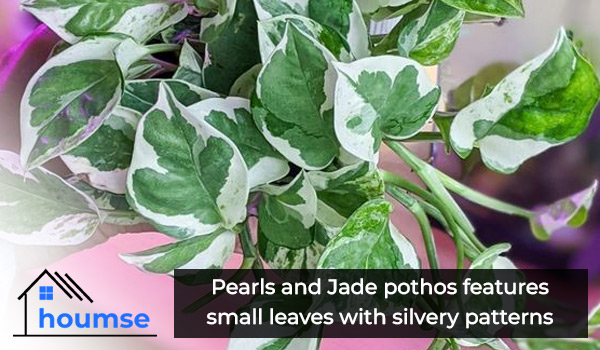
Pearls and Jade pothos is a charming variety featuring small green leaves with white and silvery-gray patterns. This plant has smaller leaves than some of the other types of pothos. Similar to Marble Queen pothos, it also has a slow growth rate, making it a great plant for tables or office desks.
Caring for Pearls and Jade pothos may not be as easy as other pothos varieties. While different types of pothos plants are almost resistant to drought, this one requires moist potting soil. If you noticed its beautiful leaves are wilting, it means that the soil is not moist enough. Pearls and Jade pothos are also a patented variety produced by Florida University.
N’Joy Pothos (Epipremnum aureum ‘N’Joy’)

Often confused with the latter variety, N’Joy pothos displays thin green and white leaves with impressive white or cream variegation. The variegation is the main feature to identify this specific version in pothos varieties.
The variegation on the N’joy small leaves has no green, while the pearls and jade pothos have green dot-like marks in their white variegation.
Jade Pothos (Epipremnum aureum ‘Jade’)
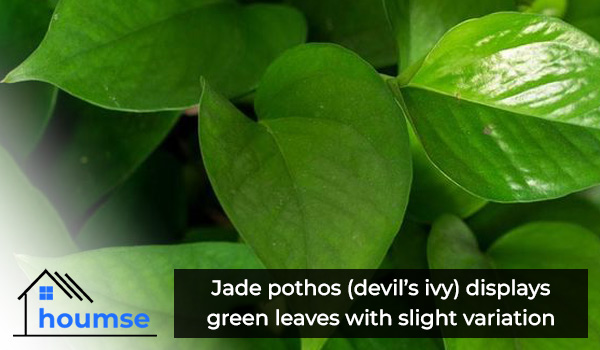
Jade pothos or devil’s ivy, is the original variety in different types of pothos plants, displaying beautiful leaves with a slight variation on the dark green. This pothos type is another popular houseplant due to its easy care.
As a pothos type suitable for indoors, its stems can grow up to 3 feet. So, you can hang them elegantly over a hanging basket or grow up a moss pole providing a vertical accent. By pruning its dense vines, you can turn it into an attractive tabletop plant as well.
While Jade pothos grows well in bright light (like other pothos varieties), it does not need much sunlight and high humidity. Therefore, it can be an excellent plant to put in the bathroom as well.
Golden Pothos (Epipremnum aureum)
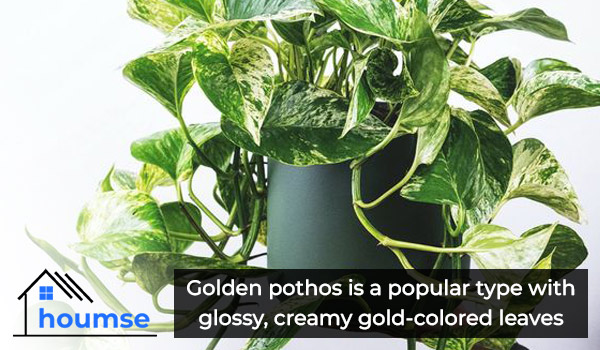
Are you looking for clean air houseplants recommended by NASA among types of pothos? Then this particular variety is for you. Golden pothos is a popular plant with glossy and creamy gold-colored leaf patterns that are similar to delicate brush strokes. As a known hanging basket plant, it helps to brighten up low-light corners in your room.
Compared to many pothos varieties, the fact that colored leaves of Golden pothos do not lose their vibrancy in shaded places and where light is usually limited is one of the outstanding features of this houseplant. You can also keep it outdoors in frost-free areas but prepare for its leaves to reach up to 12 inches wide or larger.
Glacier Pothos (Epipremnum aureum ‘Glacier’)
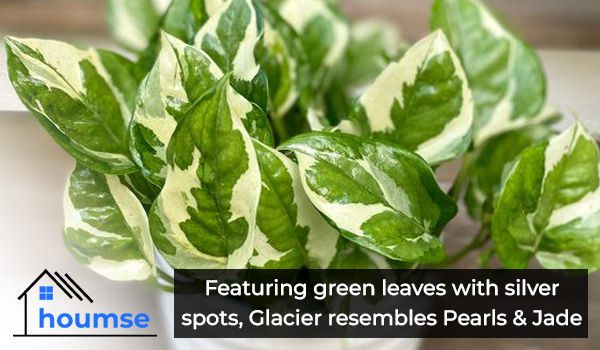
Glacier pothos is another charming vining plant with small heart-shaped leaves and a slow growth rate. Having green leaves with silver and gray spots, Glacier pothos is similar to Pearls and Jade among different types of pothos in both appearance and size.
This variety grows well even in low light spaces and survives in average room humidity. But if you want to boost its growth, simply keep it in bright light and a high humidity level. Glacier pothos has a bushy growth habit as well, making it a perfect plant for tables or desks in your house or office like several other pothos varieties.
Hawaiian Pothos (Epipremnum aureum ‘Hawaiian’)
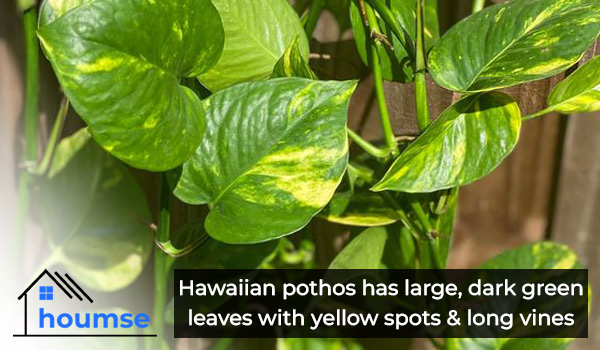
All the types of pothos introduced so far have lovely small heart-shaped. But what if you prefer larger leaves?
The Hawaiian pothos has huge leaves compared to other types of pothos plants. It has dark green leaves with yellow spots and long vines that create an impressive vertical accent in hanging baskets or growing up a pole. You do not need to worry about the size of Hawaiian pothos, as you can prune it to control the stem length and keep it compact.
Neon Pothos (Epipremnum aureum ‘Neon’)
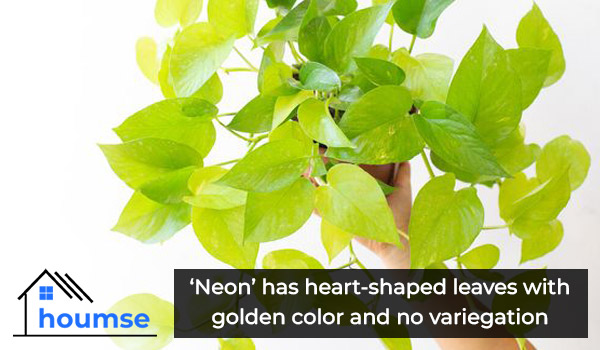
As you can tell by its name, Neon pothos is one of the most attractive types of pothos. Like almost all pothos varieties, this one also has charming heart-shaped leaves with eye-catching golden yellow color and no variegation.
New Neon pothos leaves are very bright but darken in color as they age. If you want your Neon pothos to get its electrifying bold color, keep it in bright light. Low-light spots will dull and darken their color. We recommend growing it in containers on tall DIY plant stands or hanging baskets. If you are thinking about a hard-to-reach location, growing this pothos variety in water is also a good choice.
Variegated Neon Pothos (Epipremnum aureum ‘Neon Variegata’)
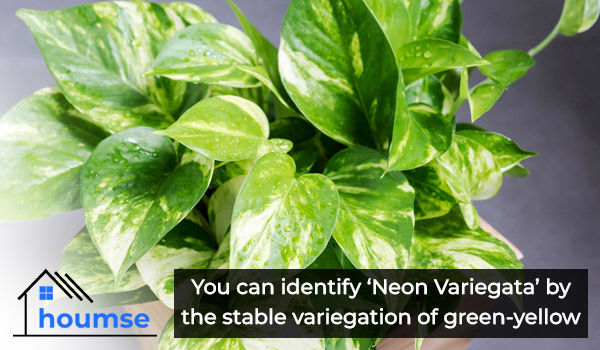
You can separate a ‘Neon Variegata’ from a ‘Neon’ by stable variegation of bright green-yellow all over its leaves. This plant also needs a location with bright, indirect light so its variegation does not revert.
Jessenia Pothos (Epipremnum aureum ‘Jessenia’)
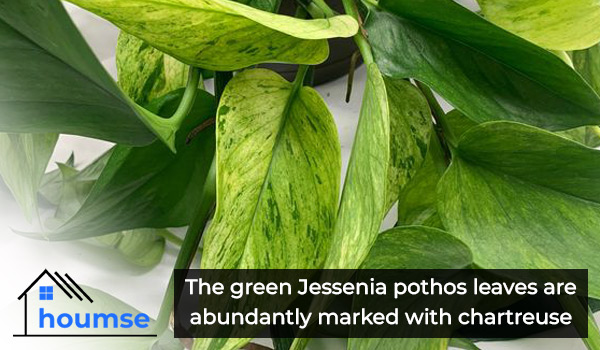
If you place a Marble Queen pothos and Jessenia pothos next to each other, it will not be too hard to tell the difference between them. The green leaves of Jessenia pothos are abundantly marked with chartreuse; and like Marble Queen, every Jessenia pothos leaf is also different. The Marble Queen pothos leaves are much lighter than the limey-green leaves of Jessenia.
And compared to Golden pothos, Jessenia tends to grow more slowly. With the increasing popularity of this plant among people, it is going to be one of the rare pothos varieties soon!
Satin Pothos (Scindapsus pictus ‘Argyraeus’)
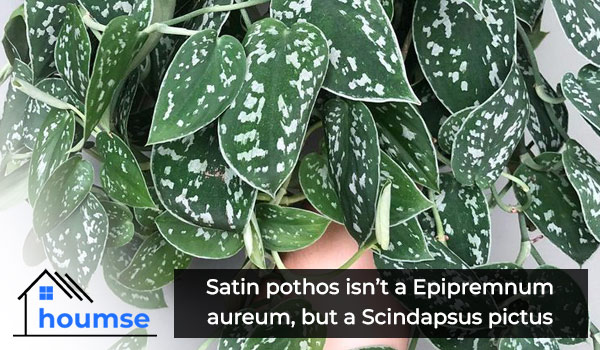
Despite its name, Satin pothos is not a true Epipremnum aureum plant. Satin pothos is actually from the genus Scindapsus pictus. The reason that it is known as a pothos, is that it has many of the common features of different types of pothos plants. It is also a climbing variety with matte dark green leaves with silvery spots, which is the reason it is also called the silver satin pothos.
When trying to identify Satin pothos, be careful not to confuse it with Philodendron silver. Although both plants have heart-shaped leaves and long, trailing stems, none of them are from the genus Epipremnum family. Therefore, they are not true types of pothos plants.
Silver Satin Pothos (Scindapsus pictus ‘Exotica’)

This is another Scindapsus pictus variety that is commonly considered one of the pothos varieties. You can tell it apart from the latter types by its leaves which are both larger and darker. Silver Satin captures the attention with its large, thick, dark green leaves decorated with silvery patterns.
Cebu Blue Pothos (Epipremnum pinnatum ‘Cebu Blue’)
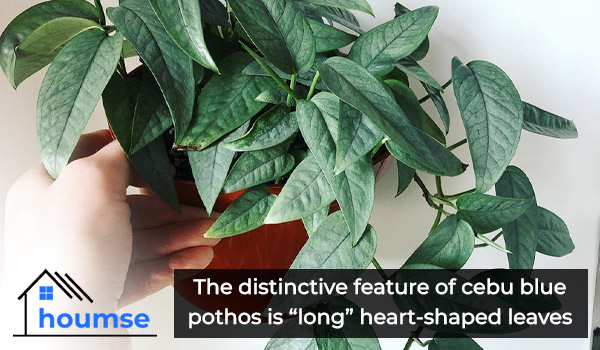
If you are interested in unusual and rare pothos, make sure to know the Cebu Blue cultivar among types of pothos.
The distinctive feature of cebu blue pothos variety is its “long” heart-shaped leaves. Rather than having a rounded shape such as other pothos varieties, it features leaves with a lance-like shape with unique foliage. This rare pothos has shiny silvery-blue leaves with eye-catching veined patterns.
If you want to grow this pothos plant, remember that it thrives in bright, indirect sunlight and high humidity levels. Regarding the watering, you only need to water it enough to keep the soil slightly moist.
Harlequin Pothos (Epipremnum aureum ‘Harlequin’)
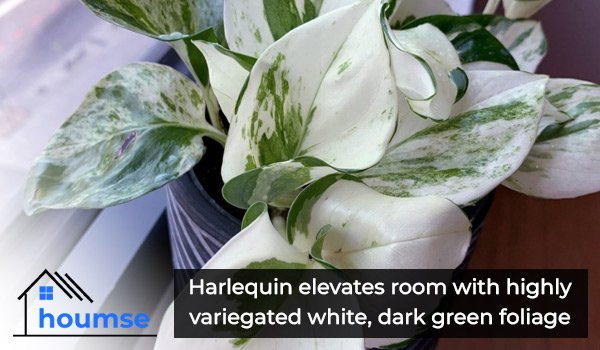
This is truly one of the most elegant as well as rare pothos varieties. Harlequin elevates any space with highly variegated white and dark green foliage without any cream-yellow coloring. With an appearance like Manjula pothos, this species thrives in bright indirect light too.
Trebi Pothos (Scindapsus pictus ‘Trebi’)

Despite its common name, the Trebi pothos is another genus Scindapsus related to the Satin pothos. Meaning that the Trebi cultivar is not a true member of pothos varieties as well. The main difference between Trebi cultivar and true types of pothos is that its leaves are not as bright and vibrant as theirs.
This vining houseplant is another (none) pothos plant with large green leaves. Compared to Satin pothos, its leaves have more differently colored zones. The matte leaves of Trebi pothos have a silver marbling effect, which gives it an amazing silver-blue appearance.
If you find Trebi pothos interesting, you might like other cultivars related to it such as Argyraeus, Exotica, and Silver Ann as well.
Dragon’s Tail Pothos (Epipremnum pinnatum)
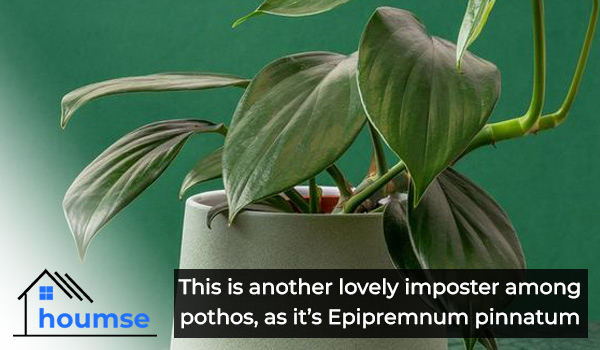
This is another lovely imposter among pothos varieties, as it is not an Epipremnum aureum, but an Epipremnum pinnatum. With requirements fairly similar to other types of pothos, this variety adorns any room with jade-green leaves that develop fenestrations as they mature.
Its leaves are small and thin when young but become larger upon aging. A location with medium to bright, indirect light is excellent for growing this specimen.
Baltic Blue Pothos (Epipremnum pinnatum ‘Baltic Blue’)
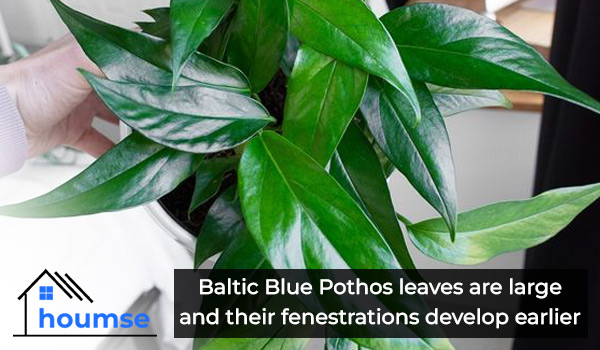
To distinguish this eye-catching variety from other types of pothos like Cebu blue and dragon tail pothos, look for dark green leaves with a blue undertone. Baltic Blue Pothos leaves are also larger, and their fenestrations develop earlier.
Global Green Pothos (Epipremnum aureum ‘Global Green’)
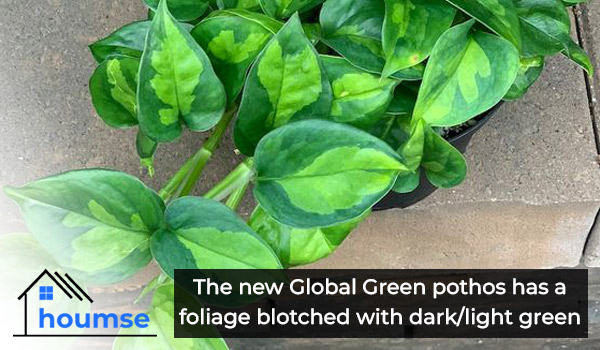
Looking for rare pothos varieties? This plant may interest you. This relatively new pothos features foliage blotched with dark and light green, resembling the N’joy or pearl and jade pothos leaves.
Although a rare variety, this houseplant is becoming more popular every day and easier to find in garden centers and nurseries.
Snow Queen Pothos (Epipremnum aureum ‘Snow Queen’)

This version may look like the Marble Queen but is it actually a more variegated pothos with stunning white foliage boasting thin green streaks. Since there are few green patches on the leaves, it is best to place ‘Snow Queen’ in bright, indirect light to prevent the leaves from reverting.
Shangri La Pothos (Epipremnum aureum ‘Shangri La’)

Commonly known as the Godzilla, Sleeping, or Spinach pothos, this species is a cultivar of the golden pothos. ‘Shangri La’ signature features include bright-green leaves with yellow variegation and a shriveled appearance. Considered one of the rare pothos varieties, this cool plant is an excellent addition to and collection.
Types of pothos Care Tips
As we mentioned, caring for types of pothos is generally easy. Pothos types indoor adapt quickly in many environments and can grow in low to medium light. However, they still need proper care. Here are the most essential tips to care for different types of pothos plants:
Soil
A light potting mix that drains well while holding moisture, is great for growing pothos varieties. It should also contain equal amounts of potting soil, perlite, and peat moss. If you notice that the soil is not draining well, change the soil to avoid root rot due to excess moisture.
Light
It is best to grow pothos types in bright, indirect light. Such light helps your pothos grow faster and keeps the leaves alive and shiny. In different types of pothos, darker-leafed types thrive best in low to minimal light environments.
Water
Only water the common and rare pothos plants when the top 1 to 2 inches of soil is completely dry. Before watering, press on the potting mix firmly. If it is dry, water the plant. And if it is moist, wait until the soil dries.
Deep watering is a suitable technique to water pothos types. In this technique, you need to wait until the soil is partly dry, and then pour water into the pot evenly until it drains out the bottom.
Fertilizer
If you want to encourage healthy growth, pour diluted houseplant fertilizers once a month during the growing season and the spring (use slow-release fertilizers in spring). During the winter don’t fertilize them, as these trailing plants grow slowly themselves.
Temperature and Humidity
Manjula pothos and other pothos varieties grow best between 65 °F and 85 °F temperatures. While the average room temperature is ideal for these plants, as tropical plants, they need medium to high humidity (at least 40%).
Pruning
Pruning pothos types indoors is not necessary considering their medium to slow growth. Still, you can trim the stems if they are too long or prefer bushy growth for your pothos.
Start with trimming any brown, dead, or decaying leaves and stems off. And remember that the best time for pruning types of pothos is in spring before they grow stronger.
What Are Your Favorite Common/Rare Pothos Varieties?
What is your experience growing types of pothos? Do you recommend a specific variety? Share your thoughts with us and other viewers in the comments.
- In this post:
- Must-Know Pothos Varieties
- Types of pothos Care Tips
- What Are Your Favorite Common/Rare Pothos Varieties?



